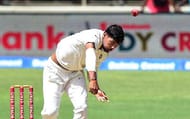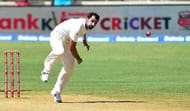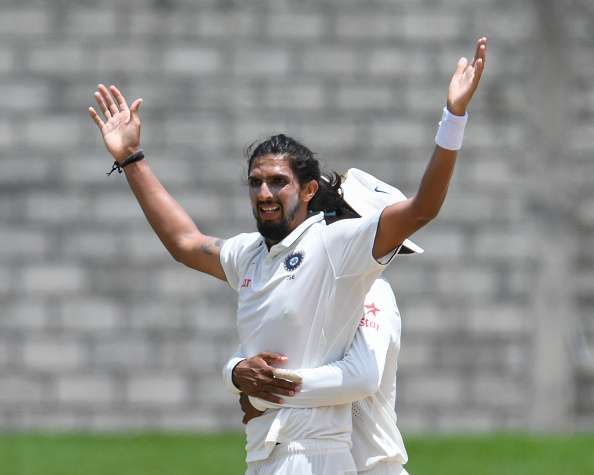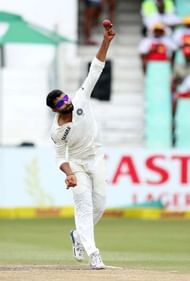Darren Sammy must be an embittered man. It’s bad enough that you’re out of the national side, nor do you get to turn out in a stadium named after you. At least the St Lucia native was spared the ignominy of ending up on the losing side in yet another five-day game. Not so for the young captain Jason Holder.
In contrast, Indian Test skipper Virat Kohli was elated at the way things unfolded on the last two days of the third match. His five-bowler theory battled not only the opposition batsmen, but also the weather elements and a pitch that chose to misbehave on odd occasions.
If it was ‘all-rounder’ R Ashwin and wicket-keeper Wriddhiman Saha’s turn to bail out the side in their first innings, Bhuvneshwar Kumar justified the faith of the think tank on the fourth day. Ishant Sharma re-discovered his nip, Mohammad Shami returned to somewhere near his best, and Ravindra Jadeja did some things with the red cherry.
Which leads us to the question: Is this India’s best ever bowling attack in Test cricket?
Signs of a pace pack coming together
What this tour has shown so far is a glimpse of a fast bowling pack coming together as a single unit. Seldom have Indian squads chosen to pick a playing eleven with three faster men – given that batting has always been their strength.
Having a frontline pacer like Umesh Yadav has only strengthened Kohli’s core belief of a razor-sharp attack. Hitting speeds upwards of 150 km/hr, the Vidarbha native has this knack of attacking the stumps and generating late swing. He might leak runs at times, but is capable of turning it around with extremely clever spells.
Yadav’s pace opens it up for the likes of Bhuvneshwar Kumar, Mohammad Shami and Ishant Sharma to combine forces and decimate rival line-ups.
The return of Bhuvneshwar Kumar and Mohammad Shami
The two UP seamers (Shami hails from Amroha while Kumar is from Meerut) have contrasting styles, but the only thing common is their ability to swing the ball.
In Bhuvi’s case, the Duke ball allows him that flexibility of generating exactly the amount of movement needed to keep the batsmen guessing. It is precisely this art of his that allowed him to dismiss Jermaine Blackwood and Marlon Samuels in the first innings.
He is not your typical, brash young tearaway. He’s methodical, aware of his limitations, and bowls well within himself. At the Beausejour, his skiddy seam-ups and fuller deliveries had the Calypsos hopping all over the place. In all respects, Bhuvneshwar Kumar is the ideal foil to the speed merchants in the side.
On the other hand, Shami is slowly re-settling into his comfort zone since his debut three years ago. Deception is one of his main strengths, and like Yadav, pace is a chief component of his arsenal.
The difference between them lies in the fact that the Delhi Daredevils strike bowler can generate plenty of conventional and reverse swing from those 140 km/hour deliveries. He also uses the bouncer to devastating effect – although, on tracks in New Zealand, Australia and South Africa, this can prove to be counter-productive.
I’d rather have Bhuvneshwar and Shami as the opening bowlers instead of either of them coming on as first change. Because the latter has the uncanny ability to grab early wickets, he needs to be in the thick of things.
Resurgent Ishant Sharma (and his man bun)
Nine years of international cricket have shown us all the myriad mass of contradictions called Ishant Sharma. When he’s not picking fights with rival batsmen or earning the censure of umpires, the Delhi lad slips into the role of the menacing fast bowler with a wicked short ball.
Sharma’s most notable quality is his wrist position when delivering the ball at speeds of around 140 km/hour. However, he does have a tendency towards profligacy, especially when bowling to left-handers – an anomaly that he has rectified to some extent in his new bowling action.
These days, he hits the deck hard and can generate large amounts of reverse swing even with the ball being relatively new. He has toiled hard without much success in the ongoing series against the West Indies, but has been able to tighten up one end and create more opportunities for his fellow quicks to strike telling blows.
Given this quartet of pace bowlers in the side, perhaps Kohli can do a rethink and have all four play in the final Test? It’d mean a longer tail, but it’s definitely worth a shot.
The spin trio has a long way to go
While off-spinner Ravichandran Ashwin has donned the mantle of leader of the tweak attack, getting reliable support in the same department seems to be a bit of a problem area.
Take Amit Mishra, for example. Once anointed as the successor to the legendary Anil Kumble, the Haryana leg-spinner has blown hot and cold in a rather interrupted international career. The kind of wickets that suit his style of bowling are usually on the quicker and bouncier side – one of the reasons for his success in Antigua.
But what happens if your variations and stock delivery are decoded by the batsmen? Debutant Roston Chase did this in Jamaica, and so have many others. Mishra then starts to be a tad erratic; trying too many things, bowling flatter and faster, and getting frustrated by the minute.
Given the Indian skipper’s penchant for leg spin, it is imperative that he hits his straps soon. All he needs to do is learn to be patient – the wickets will follow – and stick to his strengths.
Let’s move on to the third wheel of the spin armoury – Ravindra Jadeja. And once again, I am of the opinion that his presence is more of a luxury to this young side.
There is no doubt in my mind that Jadeja is a skilled cricketer, and that age is on his side. However, I have observed instances where his presence looks to be more of a journeyman cricketer than a serious all-rounder.
If left-arm spin is something that is to fetch you wickets and curtail the run scoring, then the mindset needs to be one of ruthlessness, not just containment. Plus, the Saurashtra southpaw seems to be totally disconnected from the proceedings. This could potentially backfire on the captain’s tactics.
Jadeja needs to bring in some more subtle variations in flight and pace. His arm-ball is an asset, and a round-arm action makes it even more lethal. But he has got to be able to focus better. Plus, he has to curtail bowling with a flat trajectory on slower tracks– it leaves him susceptible to heavy hitting.
Final summary
Is this still India’s best bowling attack in Tests? Only time will tell – the tracks at England, Australia, New Zealand and South Africa may well prove to be an acid test for this motley bunch. The beginning is good; sustaining it will be the key.
Check RCB Squad 2024 Details. Follow Sportskeeda for IPL 2024 Live Score, Schedule, Points Table





